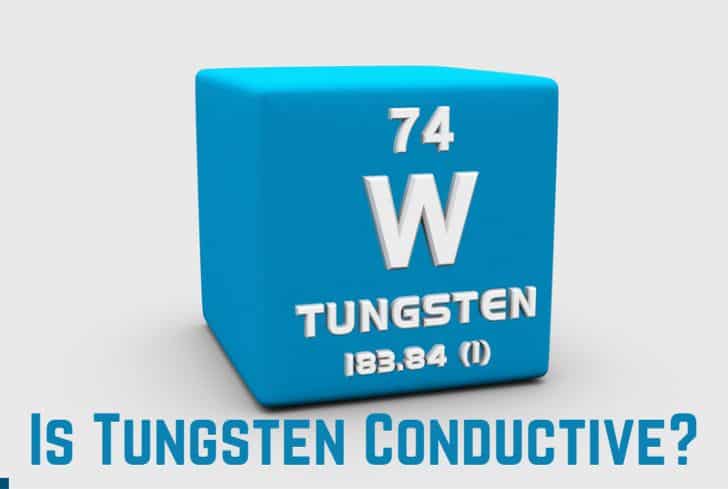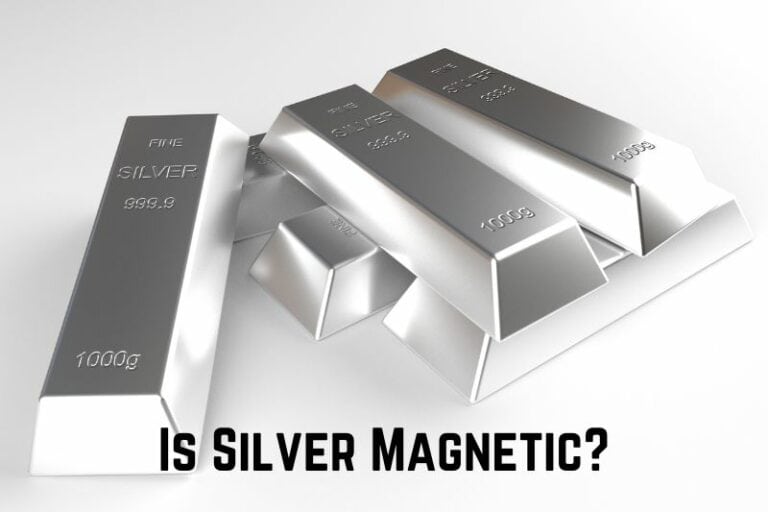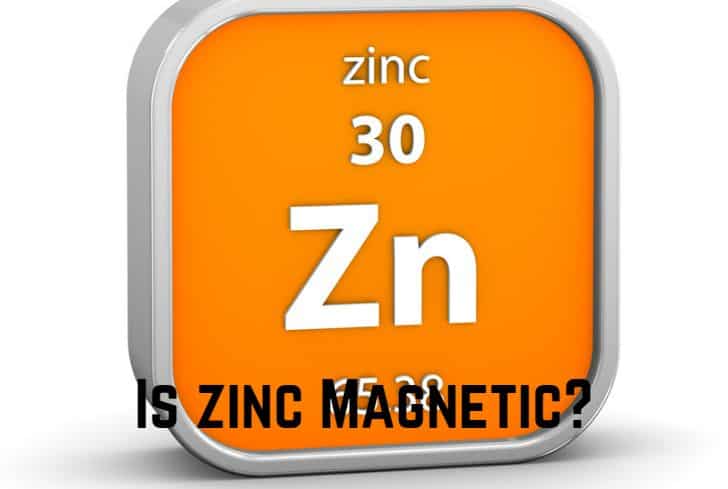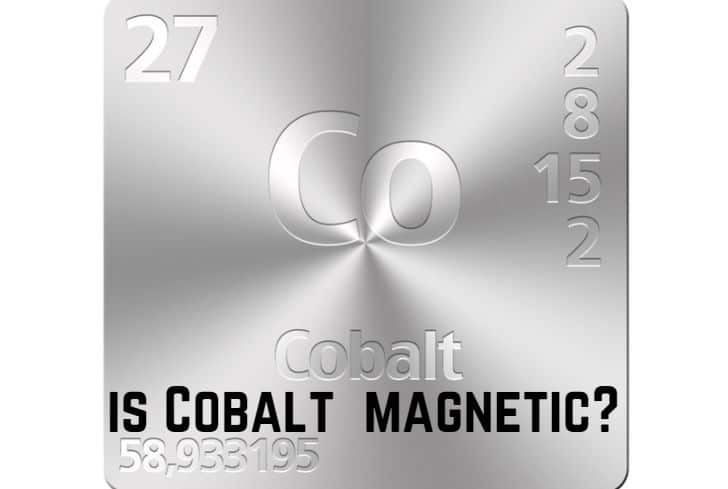Is Tungsten Conductive? (And Conduct Heat?)

More individuals are becoming aware of tungsten, which is growing in popularity. Nowadays, most men seem to favor it, especially those seeking wedding bands and men’s jewelry. Others, however, are hesitant because they are unsure of the properties of tungsten. The conductivity of tungsten is one of their concerns. So is tungsten conductive?
Given that your body will come into contact with the metal most of the time, it is a reasonable question. We discuss whether tungsten is magnetic, has a high resistance, and whether it carries heat and electricity in this article. You will learn about tungsten’s uses, properties, and whether or not tungsten carbide is conductive.
Read: Does Titanium Conduct Electricity?
Does Tungsten Conduct Electricity?
Tungsten does not conduct electricity under normal temperature conditions. The electrical conductivity of the tungsten depends on the temperature. Therefore, Tungsten only conducts electricity at higher temperatures. The outer core of tungsten contains free valence electrons. Charges in the metal are transferred in a variety of directions by the free electrons. However, the free electrons are only available for conduction at slightly higher temperatures in tungsten.
Despite having free electrons, tungsten possesses a resistive property that prevents charging at room temperature or lower. The metal is electrically conductive when it is 68°F (20°C) or higher. Tungsten has an electrical conductivity of 1.76 107 Sm-1, which is a good electrical conductive value.
Why is Tungsten a Bad Conductor?
Tungsten relies on heat resistivity, which makes it a poor conductor. Electrical conduction results from the free electron’s mobility becoming more random as the temperature rises. Tungsten stays a non-conductor if the temperature does not increase. The thermal stability of tungsten is poor at lower temperatures. Only at high temperatures does electron conduction become faster.
Due to its high electrical resistivity, tungsten has difficulty conducting electricity. Because of the restriction of the movement of electrons at low temperatures, tungsten offers considerable resistance to electric charge flow. Electric charge flow won’t be achievable if electrons find it impossible to move about due to low temperatures.
Is Tungsten Carbide Conductive?
Tungsten carbide is a good conductor of electricity. Cobalt is a binder when producing tungsten carbide, making the metal conductive. Electrical conductivity in tungsten carbide increases as cobalt content rises. Sometimes, nickel is used as a binder, making tungsten carbide conductive. Cobalt and nickel are good conductors as they allow electrical current flow.
However, jewelry made of tungsten carbide does not conduct electricity. The tungsten carbide used to manufacture these products is cemented carbide. Instead of becoming metallic, tungsten carbide becomes ceramic. The tungsten carbide must be free of cobalt, as this metal can irritate the skin and cause allergic reactions.
Chemically speaking, tungsten carbide is a mixture of tungsten and carbon atoms. In the presence of hydrogen, the chemical is created by burning carbon black with tungsten. In its simplest form, it is a powder. However, tungsten carbide compacts and creates a solid mass through sintering. The density and toughness of tungsten carbide metal are nearly two times those of steel.
Does Tungsten Conduct Heat?
Tungsten is a poor conductor of heat. It has minimal thermal expansion to allow heat to pass through it. The ratio at which a material expands in response to temperature variations is known as the coefficient of thermal expansion. Strong bonding gives metals with high melting points, like tungsten, a poor thermal expansion capacity.
Tungsten has a high melting point of 6170°F(3410°C). Out of all metals, it is the highest. But tungsten still retains its strength even at this temperature. However, tungsten has a low heat conductivity due to its high melting point. The tungsten’s atoms vibrate with more energy as the temperature rises, which makes it challenging for electrons to move. Thermal conductivity, therefore, diminishes as temperature rises.
The amount of free space for electrons decreases as vibration increases. Lattice vibrations (phonons) and free electrons are the two mechanisms that transfer heat energy in solids. Thermal conduction in metals is primarily due to the movement of electrons. With the increase in temperature, the number of carrier electrons and the contribution of lattice vibrations increases.
While most expect a rise in thermal conduction, electron mobility decreases due to lattice vibrations. The reaction of metals’ thermal conductivity will differ due to those factors. The thermal conductivity of tungsten decreases as temperature rises.
Read: Does Graphite Conduct Electricity?
Does Tungsten Have High Resistance?
Tungsten has a high level of resistance, thus indicating that tungsten has a high resistance to the flow of electrons or current. At 20 °C, tungsten has a resistivity of 52.8 Ωm. The ions in the metal potentially clash with moving electrons. Resistance results from the impact, which makes it difficult for the current to flow.
The resistance of a certain material at a particular size( length and cross-section area) is known as resistivity. The SI term for resistivity is “ohm-meter,” also represented by the symbol m. A substance with a high resistivity is typically a poor conductor of electricity.
Resistivity is affected by temperatures, and in most materials, resistivity increases with temperature. Tungsten is different because when the temperature rises, the resistivity decreases.
Is Tungsten Magnetic?
Tungsten is paramagnetic, which means that it has a few magnetic properties. The four unpaired electrons in tungsten’s outer shell cause the metal’s paramagnetism. The magnetic dipole moment created by the spinning electrons allows them to function as small magnets. The presence of an external field causes the electrons to spill parallel to one another, creating a net attraction.
The magnetic moment of an element that creates a magnetic field is its magnetic pull and direction. The alternative name for a magnetic moment is a magnetic dipole moment. The magnetic moment has separate positive and negative charges stabilizing themselves at the north and south pole.
Learn more about magnets and magnetic fields:
Properties of Tungsten
The chemical element tungsten, sometimes called wolfram, has an atomic number of 74. Although rare, it is frequently alloyed with other metals. However, as highlighted below, it has several properties.
1. Non-reactive
Tungsten does not react with oxygen at room temperature. But when the temperature goes above room temperature, tungsten reacts with oxygen. It can also react with carbon in high temperatures to form tungsten carbide. It does not react with water.
2. Hard
Tungsten is a hard metal and is mainly used in the steel industry. It has a nickel-white to grayish luster. It has the highest tensile strength at 3,002 °F(1,650 °C) among metals.
3. Malleable
Due to its malleability, tungsten is easily formed into a wire. The most popular way of creating shapes is sintering. However, you can also apply forging, extrusion, or drawing techniques. High strength and comparatively easy workability distinguish tungsten from most metals.
4. Dissolves in a mixture of acids
At room temperature, tungsten will only dissolve in a solution of acids, such as nitric acid and hydrochloric acid. It is not, however, attacked by other acids. Alkaline solutions like blended potassium nitrate, sodium peroxide, and sodium hydroxide mixes also allow it to dissolve. Aqueous alkalies do not affect tungsten, though.
5. Can combine with halogens
Halogens like iodine, chlorine, and fluorine can mix with tungsten. However, the metal cannot combine through hydrogenation.
Uses of Tungsten
Because of its broad properties, tungsten has numerous uses in various industries. Chemical vapor deposition and selective laser melting are two processes used to manufacture tungsten products because of its high ductile-brittle transition.
Manufacturing of alloys
Steel and other metals can grow stronger when tungsten is added as an alloy. It increases the other metal’s hardness, tenacity, strength, and flexibility. Radiation shielding and the aerospace and automotive industries employ 90% of tungsten alloys. Wear-resistant parts, coatings, and turbine blades are made from superalloys containing tungsten.
Manufacture of electric components
Electric light bulbs are made with tungsten, which is quite useful. Tungsten is used to create the filament’s thin film. The filament will heat up to a suitable temperature and emit visible light without melting because of the tungsten’s incandescence. Since tungsten won’t melt at incandescence temperature in a vacuum, the filament is covered by a vacuum bulb.
Due to its ability to tolerate intense heat, tungsten is a perfect material for electronics. In integrated circuits, it serves as a material for interconnecting the silicon dioxide dielectric layer and transistors. The metal’s electric structure also makes it one of the most popular x-ray targets.
Industrial and other applications
Cemented carbide is the most common application of tungsten. It is widely used in the manufacture of cutting and mining products. Some of the most common products include milling cutters, lathe tools, high-speed cutting tools, and drill bits.
Because tungsten has a similar thermal expansion to borosilicate glass, it is used to produce glass-to-metal sealing. Tungsten has a similar density to gold; hence it can be used as a gold or platinum alternative to make jewelry.
Conclusion
Tungsten only acts as an electrical conductor when temperatures are elevated. It is also somewhat magnetic and a poor heat conductor. On the other hand, tungsten carbide has cobalt and nickel as binders, making it an excellent conductor of heat and electricity. Despite tungsten being a poor conductor of heat and electricity, it has many uses in most fields thanks to its other properties.






